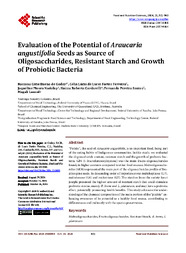Evaluation of the potential of Araucaria angustifolia seeds as source of Oligosaccharides, resistant starch and growth of probiotic bacteria.
Evaluation of the potential of Araucaria angustifolia seeds as source of Oligosaccharides, resistant starch and growth of probiotic bacteria.
Author(s): GODOY, R. C. B. de; FERREIRA, C. de L. F.; NADOLNY, J. M.; CARDARELLI, H. R.; SANTOS, F. P.; LEONEL, M.
Summary: “Pinhão”, the seed of Araucaria angustifolia, is an important food, being part of the eating habits of Indigenous communities. In this study, we evaluated the oligosaccharide content, resistant starch and the growth of probiotic bacteria. GF4 (1-fructofuranosylnystose) was the main fructo-oligosaccharides found, in higher contents compared to other food sources. Maltooligosaccharides (MOS) represented the main part of the oligosaccharides profile of Bra- zilian pine seeds. In descending order of importance was maltoheptaose (G7), maltohexose (G6) and maltotriose (G3). The starches from the variety Sanct josephi presented the highest amount of resistant starch that could stimulate probiotic strains, mainly B. breve and L. plantarum, and may have a prebiotic effect, potentially promoting health benefits. This study advances the understanding of the chemical composition of the main portion of the “pinhão” enhancing awareness of its potential as a healthy food source, contributing to different uses and indirectly with the species preservation.
Publication year: 2024
Types of publication: Journal article
Unit: Embrapa Forestry
Related content
Observation
Some of Embrapa's publications are published as ePub files. To read them, use or download one of the following free software options to your computer or mobile device. Android: Google Play Books; IOS: iBooks; Windows and Linux: Calibre.
Access other publications
Access the Agricultural Research Database (BDPA) to consult Embrapa's full library collection and records.
Visit Embrapa Bookstore to purchase books and other publications sold by Embrapa.

